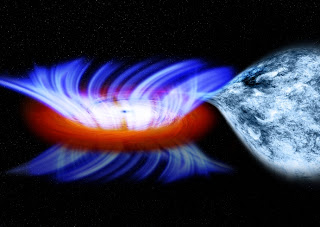 | ||
Artist of IGR J17091 (NASA)
|
Black holes occur when a star has a mass of undergoing gravitational collapse. Usually the black hole has a mass of 5 to 10 times the sun. The stellar-mass black hole powering this super wind is known as IGR J17091-3624, IGR J17091 or for short. "This is like the cosmic equivalent of winds from a category five hurricane," said Ashley King from the University of Michigan, lead author of the study published in the February 20 issue of The Astrophysical Journal Letters. "We Were not expecting to see Such powerful winds from a black hole like this."
However, wind speeds around IGR J17091 quite possible generated by supermassive black holes (black holes with masses millions of times bigger than the sun). "It's a surprise this small black hole is Able to Muster the wind speeds Typically we only see in the giant black holes," said co-author Jon M. Miller, also from the University of Michigan. "In other words, this black hole is performing well above its weight class."
However, wind speeds around IGR J17091 quite possible generated by supermassive black holes (black holes with masses millions of times bigger than the sun). "It's a surprise this small black hole is Able to Muster the wind speeds Typically we only see in the giant black holes," said co-author Jon M. Miller, also from the University of Michigan. "In other words, this black hole is performing well above its weight class."
In fact, an estimated 95 percent of the material contained by the black hole was thrown out. It is not unusual for a black hole that is always trying to pull into the material around it. "Contrary to the popular perception of black holes pulling in all of the material That gets close, we estimate up to 95 percent of the matter in the disk around IGR J17091 is Expelled by the wind," King said.
Unlike winds from hurricanes on Earth, the wind from IGR J17091 is blowing in many different directions. This pattern also distinguishes it from a jet, where material flows in highly focused beams perpendicular to the disk, often at nearly the speed of light.
Simultaneous observations made with the National Radio Astronomy Observatory's Expanded Very Large Array showed a radio jet from the black hole was not present when the ultra-fast wind was seen, although a radio jet is seen at other times. This agrees with observations of other stellar-mass black holes, providing further evidence the production of winds can stifle jets.
The high speed for the wind was estimated from a spectrum made by Chandra in 2011. Ions emit and absorb distinct features in spectra, which allow scientists to monitor them and their behavior. A Chandra spectrum of iron ions made two months earlier showed no evidence of the high-speed wind, meaning the wind likely turns on and off over time.
Astronomers believe that magnetic fields in the disks of black holes are responsible for producing both winds and jets. The geometry of the magnetic fields and rate at which material falls towards the black hole must influence whether jets or winds are produced.
IGR J17091 is a binary system in which a sun-like star orbits the black hole. It is found in the bulge of the Milky Way galaxy, about 28,000 light years away from Earth.
This article has edited by author of threelas
Source: http://www.nasa.gov/home/hqnews/2012/feb/HQ_12-056_Chandra_Fastest_Black_Hole_Wind.html
sepertinya suka jalan2 ke web AOL yah...hihihihi
ReplyDelete